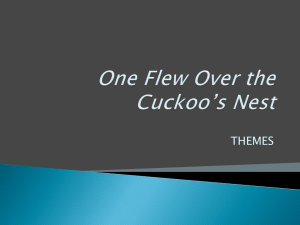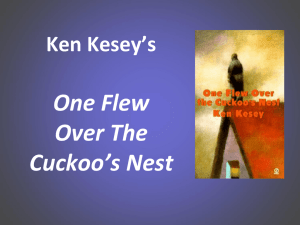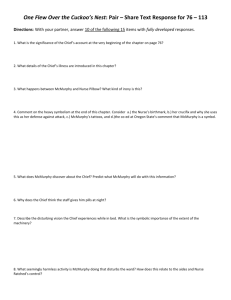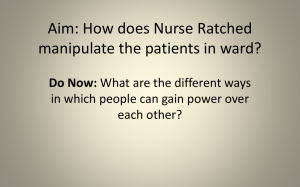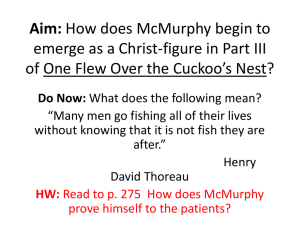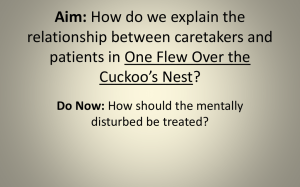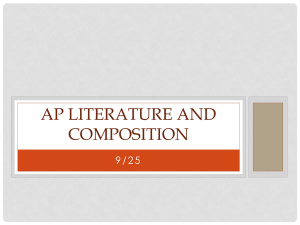POV Essay Student Example
advertisement
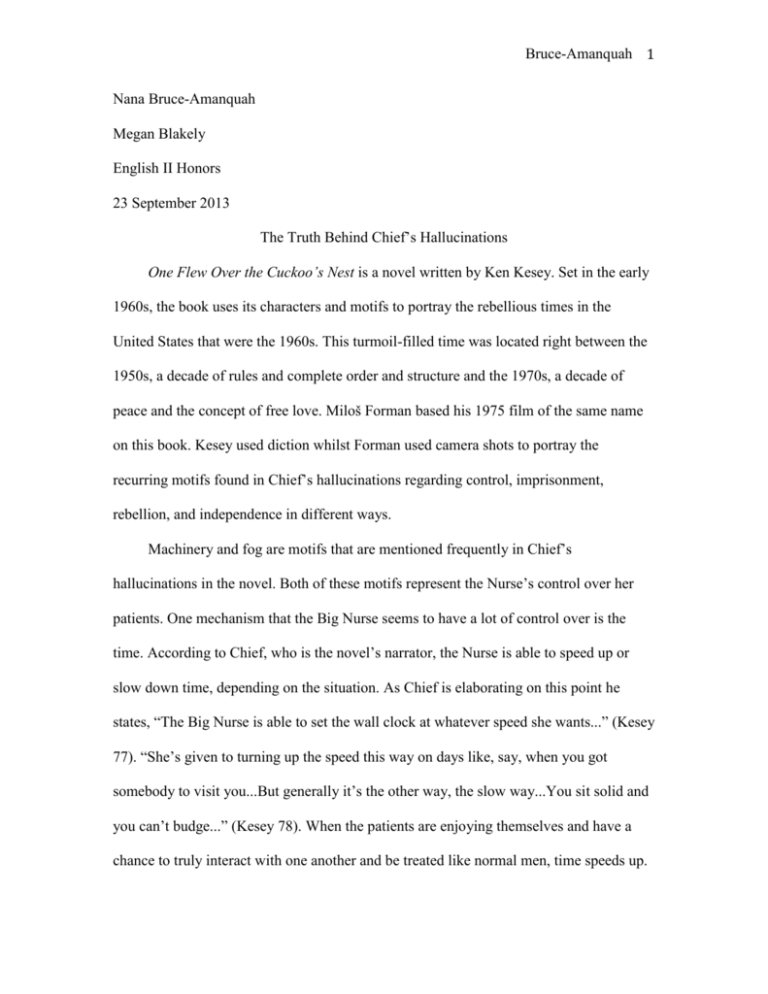
Bruce-Amanquah 1 Nana Bruce-Amanquah Megan Blakely English II Honors 23 September 2013 The Truth Behind Chief’s Hallucinations One Flew Over the Cuckoo’s Nest is a novel written by Ken Kesey. Set in the early 1960s, the book uses its characters and motifs to portray the rebellious times in the United States that were the 1960s. This turmoil-filled time was located right between the 1950s, a decade of rules and complete order and structure and the 1970s, a decade of peace and the concept of free love. Miloš Forman based his 1975 film of the same name on this book. Kesey used diction whilst Forman used camera shots to portray the recurring motifs found in Chief’s hallucinations regarding control, imprisonment, rebellion, and independence in different ways. Machinery and fog are motifs that are mentioned frequently in Chief’s hallucinations in the novel. Both of these motifs represent the Nurse’s control over her patients. One mechanism that the Big Nurse seems to have a lot of control over is the time. According to Chief, who is the novel’s narrator, the Nurse is able to speed up or slow down time, depending on the situation. As Chief is elaborating on this point he states, “The Big Nurse is able to set the wall clock at whatever speed she wants...” (Kesey 77). “She’s given to turning up the speed this way on days like, say, when you got somebody to visit you...But generally it’s the other way, the slow way...You sit solid and you can’t budge...” (Kesey 78). When the patients are enjoying themselves and have a chance to truly interact with one another and be treated like normal men, time speeds up. Bruce-Amanquah 2 During moments that the men really want to get over with, such as the group “therapy” sessions the Nurse organises, time goes at an excruciatingly slow pace. These group sessions are very every-man-for-himself situations. The patients peck at each other’s secrets whilst the Nurse watches and records them to be used against the patients later as emasculating tools. Her intentions are clearly revealed to the patients after McMurphy arrives and starts being very rebellious, causing the perfect clockwork that is the Nurse’s control to slightly unwind. To retaliate against him, the Nurse uses another weapon from her arsenal: the fog machine. Chief observes that ever since McMurphy’s been jumping on the Nurse’s last nerves, the fog machine has been used more frequently. “All this morning I been waiting for them to fog us in again. The last few days they been doing it more and more. It’s my idea they’re doing it on account of McMurphy” (Kesey 132). Before McMurphy, the fog is simply used to disorientate the patients, making them so addlebrained that all they can do is continue with their day, no questions asked. After McMurphy quickly begins to show that he’s going to be an obstreperous pain for the Nurse, the amount of fog increases, most likely as an attempt to muddle the defiant thoughts in McMurphy’s head. The time speeding and the fog machine are frequent subjects in Chief’s hallucinations, and readers of this novel often question whether these ideas are actually real. The reality or hyperbole of these hallucinations is made clear to the members of the audience that have read the book prior to watching the movie. The movie is set in third person limited, a big contrast from the first person narrative that Chief provided in the novel. Chief and his thoughts are not the main focus, which means that the things that he only imagined don’t appear in the movie at all. There Bruce-Amanquah 3 is no mention whatsoever of machines, let alone one that creates fog, and there is no reference to the Nurse speeding or slowing down time. Instead, the Nurse’s station and the wire fences that are subtly shown in medium shots displaying the film’s setting show the theme of control. But once McMurphy is able to overcome both the Nurse’s station and the wire fences, these motifs begin to connect more to rebellion and independence. In the first few days McMurphy is in the ward, he becomes irritated by how loud the ward music is. Most of the patients have been in the ward for so long that they don’t even notice it anymore, but McMurphy’s new so he is disturbed. Instead of looking around for the Nurse and asking her to turn it down, he goes straight into the Nurse’s station, a forbidden fortress to the patients, to turn it down himself. This is the first time McMurphy openly defies one of the Nurse’s policies. Later on in the film, McMurphy attempts to dislodge a fountain in the bathroom and hurl it through the glass around the Nurse’s station so he can escape and watch a baseball game. The Nurse sits in the Nurse’s station most of the time and whilst she’s there, the glass protects her and resembles her status as the barrier in the ward standing between the patients and their freedom. Trying to pick up the fountain is the first time McMurphy talks about escaping the ward. The next time he does, he’s more successful. When McMurphy is able to climb up the single barbed wire fence separating him and the other patients on the ward’s outdoor basketball court from the more liberal Outside World, he’s overcoming that last barrier and the wire fence becomes a symbol of independence, not control. After McMurphy walks away, free on the other side, the camera zooms in on a close up of Chief looking on with a smile on his face. He himself is still trapped behind the wire fence, but the point is Bruce-Amanquah 4 that now he knows that he can overcome that fence. To the patients, McMurphy embodies the gutsy personality they all want to be able to escape the strictly ordered lives they live now and have no real control over. Before McMurphy came along, the patients had accepted the fact that these were their lives. After he arrives, convinces them that life can be better, and then proving his open disregard for the rules by climbing over that fence, he gives hope that they can branch away, too. Both Miloš Forman and Ken Kesey are able to portray motifs that not only show how much prison-like control the Nurse has over her patients, but also how desperately the patients in the ward crave freedom from it. Both the film and the novel are also able to display how quickly McMurphy is to step up as an example the patients can follow to gain this freedom. Most of the machinery that Chief mentions in the novel is not real but the effect that the Nurse and McMurphy each have on the patients is, because we can see those effects through all the characters in the movie, and not just through one character’s head. Chief may have expressed this point through certain objects that didn’t exist in the film, but the idea of rebellion overcoming control to gain independence is still the same, whether you’re exposed to the story through Chief’s point of view or not. Bruce-Amanquah 5 Works Cited Kesey, Ken. One Flew Over the Cuckoo’s Nest. New York: First Signet Printing, 1962. Print. Forman, Miloš, dir. One Flew Over the Cuckoo’s Nest. Fantasy Films, 1975. Film. Bruce-Amanquah 6 Rubric: Ms. Blakely’s Comments: Nana, This essay is really exemplary. The only points you got taken off were for a few MLA and grammatical mistakes and that some of your examples could have been explained a little bit more in depth in terms of the impact on the viewer. This is a really great paper; awesome job!
